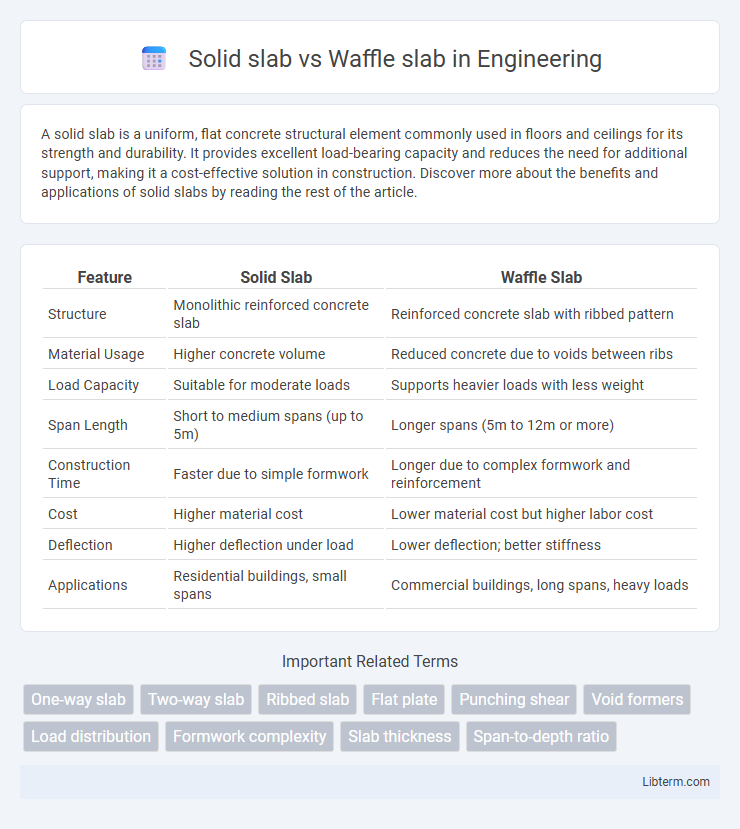A solid slab is a uniform, flat concrete structural element commonly used in floors and ceilings for its strength and durability. It provides excellent load-bearing capacity and reduces the need for additional support, making it a cost-effective solution in construction. Discover more about the benefits and applications of solid slabs by reading the rest of the article.
Table of Comparison
| Feature | Solid Slab | Waffle Slab |
|---|---|---|
| Structure | Monolithic reinforced concrete slab | Reinforced concrete slab with ribbed pattern |
| Material Usage | Higher concrete volume | Reduced concrete due to voids between ribs |
| Load Capacity | Suitable for moderate loads | Supports heavier loads with less weight |
| Span Length | Short to medium spans (up to 5m) | Longer spans (5m to 12m or more) |
| Construction Time | Faster due to simple formwork | Longer due to complex formwork and reinforcement |
| Cost | Higher material cost | Lower material cost but higher labor cost |
| Deflection | Higher deflection under load | Lower deflection; better stiffness |
| Applications | Residential buildings, small spans | Commercial buildings, long spans, heavy loads |
Introduction to Solid Slab and Waffle Slab
Solid slabs are flat, uniform concrete slabs commonly used in residential and commercial buildings for their simplicity and cost-effectiveness in supporting moderate loads. Waffle slabs feature a grid pattern of ribs on the underside, optimizing material usage and providing greater load-bearing capacity and reduced weight for large-span structures. The choice between solid and waffle slabs depends on structural requirements, span length, and architectural considerations.
Key Differences Between Solid Slab and Waffle Slab
Solid slabs are flat, uniform concrete slabs offering straightforward construction and are typically used for smaller spans with consistent load distribution. Waffle slabs feature a grid of ribs on the underside, reducing material use while increasing strength, making them ideal for longer spans and heavy loads. The key differences lie in their structural efficiency, material consumption, and suitability for varying architectural requirements.
Structural Composition of Solid Slab
The structural composition of a solid slab consists of a uniform thickness reinforced concrete element that distributes loads evenly across its surface without the need for beams, providing simplicity in design and construction. This monolithic structure offers high durability and load-carrying capacity, making it suitable for short to medium spans, typically up to 5 meters. Solid slabs rely on steel reinforcement arranged in a grid pattern to resist tensile forces and prevent cracking under bending stress.
Structural Composition of Waffle Slab
Waffle slabs feature a grid of ribbed beams created by molds or forms, providing a reinforced concrete structure with reduced weight compared to solid slabs. The structural composition includes a series of beams intersecting at right angles, forming a deep ribbed framework that enhances load distribution and increases bending resistance. This configuration allows for longer spans and better material efficiency, making waffle slabs ideal for large floor areas with minimal support columns.
Load-Bearing Capacity Comparison
Waffle slabs offer superior load-bearing capacity compared to solid slabs due to their ribbed structure that efficiently distributes weight and reduces concrete usage. The grid pattern in waffle slabs enhances stiffness and supports heavier loads over larger spans, making them ideal for commercial buildings with high load demands. Solid slabs, while simpler and more cost-effective for short spans, generally bear less load and are better suited for lighter structures or residential applications.
Material Efficiency and Cost Analysis
Waffle slabs offer superior material efficiency by using less concrete and steel due to their ribbed design that reduces weight while maintaining strength, making them cost-effective for long spans and heavy loads. Solid slabs require more concrete and reinforcement, increasing material costs but providing simpler formwork and faster construction, which can reduce labor expenses. Overall, waffle slabs yield better savings on materials, whereas solid slabs may offer lower initial labor costs, requiring a detailed project-specific cost analysis for optimal selection.
Construction Methods and Installation Time
Solid slabs are constructed by pouring concrete into uniform formwork supported by props, resulting in straightforward and faster installation suitable for shorter spans. Waffle slabs require a grid of ribs formed by reusable molds or permanent pans beneath the slab, increasing complexity and installation time but reducing material use and weight. Installation time for waffle slabs is longer due to the additional formwork setup, but they provide enhanced load distribution and structural efficiency for larger spans.
Typical Applications and Best Uses
Solid slabs are commonly used in residential buildings, commercial floors, and parking decks due to their simplicity and cost-effectiveness for moderate spans. Waffle slabs are ideal for large commercial spaces, auditoriums, and areas requiring heavier loads and long spans, offering increased rigidity with less material usage. The choice depends on load requirements, span length, and architectural design preferences.
Pros and Cons of Solid Slab Systems
Solid slab systems offer simplicity in design and construction, providing uniform load distribution and excellent durability for residential and commercial buildings. They are advantageous due to their ease of formwork preparation and faster installation compared to more complex waffle slabs, but can be heavier and use more material, leading to increased structural weight and cost. Limited spanning capacity and less architectural flexibility are drawbacks, making solid slabs less suitable for large open spaces compared to waffle slabs, which provide higher strength-to-weight ratios and better insulation properties.
Pros and Cons of Waffle Slab Systems
Waffle slab systems offer superior load distribution and reduced material usage compared to solid slabs, providing enhanced structural efficiency and aesthetic appeal through their grid pattern. Their advantages include lightweight construction, improved span capabilities, and inherent resistance to bending and shear forces, making them ideal for large open spaces. However, waffle slabs require complex formwork and longer construction time, along with higher initial costs and potential challenges in embedding utilities within the slab.
Solid slab Infographic

 libterm.com
libterm.com